|
LOCAL FOLKS
Cigar label photographs, and portraits with such personality
that they could only have been based on real people, provide tantalizing
views of individuals living in 19th-century Canada's small communities and
seldom known beyond them.
Some of these views are on vanity or custom brands produced
by makers with their own likeness (or that of their horse!), or ordered by
customers wishing to offer a houseguest a cigar box with the host's own
name and portrait smiling up from the lid.
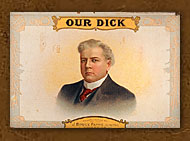 |
 |
OUR DICK
Trimmed nailed wood box (50)
Factory 1 IRD 10 Circa 1915
J. Bruce Payne, Granby, Que.
CMC 2003.46.36
"Our Dick" was Richard McBride, Premier of British
Columbia from 1903 to 1915. McBride was the first B.C.-born premier and the
only one ever to be knighted. McBride, B.C. is named for him. McBride's most
famous deed was to buy two American-built submarines in early August 1914,
just before American neutrality laws that would have prevented the sale came
into effect. A few days later, the submarines were taken over by the Dominion
government.

|
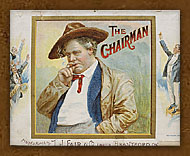 |
 |
THE CHAIRMAN
Trimmed nailed wood box (50)
Factory 2 IRD 31 circa 1897
T. J. Fair & Co., Limited, Brantford, Ont.
CMC 2004.216.12 |

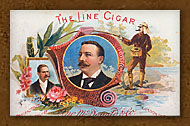 |
 |
THE LINE CIGAR
Trimmed nailed wood box
Factory 9 IRD 32 Series of 1897
Line, McDonald & Co, London, Ont.
CMC 2001.185.20 Tony Hyman Collection |

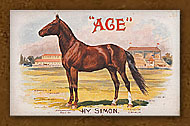 |
 |
ACE
Trimmed nailed wood box (50)
Factory 4 IRD 32 Series of 1897
Hy. Simon, London, Ont.
CMC 2001.185.19 Tony Hyman Collection |

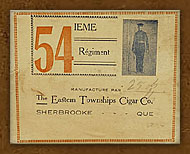 |
 |
54IEME RÉGIMENT

Trimmed nailed wood box (50)
Factory 7 Port 16D Circa 1924–27.
Eastern Townships Cigar Company, Sherbrooke, Que.
CMC 2004.38.52 Echenberg Collection |

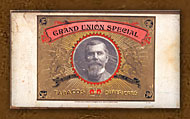 |
 |
GRAND UNION SPECIAL
Book-shaped wood box (50)
Factory 21 IRD 32 Series of 1897
Stirton & Dyer, London, Ont.
CMC 2003.46.63 |

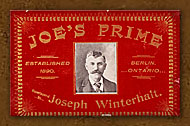 |
 |
JOE'S PRIME
Trimmed nailed wood box (50)
Factory 7 IRD 28 Series of 1897
Joseph Winterhalt, Berlin, Ont.
CMC 2003.46.61 |

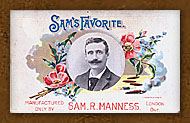 |
 |
SAM'S FAVORITE
Trimmed nailed wood box
Factory 16 IRD 32 Series of 1897
Sam. R. Manness, London, Ont.
CMC 2001.185.13 Tony Hyman Collection |
LOCAL LEGENDS
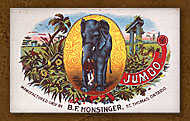 |
 |
JUMBO
Trimmed nailed wood box (50)
Factory 13 IRD 32 Series of 1897
B. F. Honsinger, St. Thomas, Ont.
CMC 2003.46.160
On September 15, 1885, Jumbo, the largest elephant ever held
in captivity (3.5 metres tall, weighing approximately 6 tonnes, with a trunk
70 centimetres in circumference) was killed by a train while on tour with the
Barnum and Bailey circus in the southwest Ontario town of St. Thomas.
According to one story, Jumbo and a dwarf elephant, Tom Thumb, had been
taken by their keeper, Matthew Scott, for an evening walk by the railroad
tracks. Tom Thumb strayed onto the tracks just as an unscheduled train
approached. Jumbo protectively placed himself between the train and Tom Thumb,
and was killed. Scott wept.
Barnum, who had purchased Jumbo from the London Zoo for
$10,000, offset his financial loss by having Jumbo's hide and skeleton put
on display. St. Thomas cigar maker B. F. Honsinger cashed in by marketing a
line of Jumbo cigars. Its label featured an image of the pachyderm with
Scott standing in the curl of his trunk.
Jumbo's skeleton is now at the American Museum of Natural
History in New York. A giant—in fact, jumbo-sized—statue was erected by
the city of St. Thomas in 1985.

|
 |
 |
JOE. MONTFERRAND
Trimmed nailed wood box (50)
Factory 1 IRD 17 Series of 1897 (ca. 1912)
Adam Beck, Montreal, Que.
CMC 2003.46.102
Joseph Montferrand (1802–1864) was a Montreal voyageur, logger
and strongman whose exploits made him a French-Canadian people's champion
and a legend from the Ottawa Valley to his native city. His reputation was
built on thrashing bullies and trouncing gangs of ruffians of various
backgrounds—English, Irish, American—in northern logging camps and the border
towns of Bytown (later Ottawa) and Hull. In modern times, he has been
commercialized as "Joe Mufferaw" in English-language popular song
and Ottawa Valley tourist and children's literature.
In the early 1900s, the French Canadian popular hero was
honoured with his own brand of cigars. The inner label shows scenes from
four stories associated with Montferrand, captioned in French:
leaving the
imprint of his boot on a tavern ceiling as a "calling card;"
defeating an English garrison's boxing champion;
turning the tables on a
bully; and swinging an opponent's body to rout 100 "Shiners"
(Orangemen) on the bridge from Bytown to Hull. |
NEW HEROES
Early cigar boxes show the national cult of celebrity—in personalities
from politics, the military, even education—developing in late-19th-century
Canada.
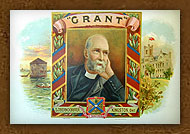 |
 |
GRANT
Trimmed nailed wood box (10)
Factory 1 IRD 22 Series of 1897
S. Oberndorffer, Kingston, Ont.
CMC 2003.46.73
Label: National Archives
The Reverend George Monro Grant
(1835–1902) was the much-loved
principal of Queen's University during the last quarter of the 19th century.
Grant's vision—and fund-raising acumen—made Queen's one of Canada's leading
institutions of higher learning.
Early in life, Grant had accompanied Sanford Fleming on the
expedition to survey the route for the Canadian Pacific Railway; the experience
deepened his sense of nationalism which he described in his popular book, Ocean to Ocean. Grant remained an influential thinker and
shaper of public opinion. Shortly before he died, his students raised funds
to erect a building on campus in his honour. He did not live to see Grant
Hall's limestone tower, Queen's best-known landmark, completed in 1905.
Grant's descendents include philosopher George Grant, author of Lament for
a Nation, and historian-journalist Michael Ignatieff.
Perhaps "Grant" cigars, by local Kingston manufacturer,
S. Oberndorffer, were sold to raise funds for Grant Hall. The label, shown here
in its entirety (the one on the Canadian Museum of Civilization's
small, 10-cigar box was trimmed to fit)
shows the edifice on one side and one of the city's renowned Martello towers
on the other.

|

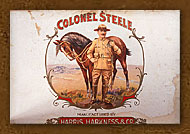 |
 |
COLONEL STEELE
Trimmed nailed wood box (50)
Factory 35 IRD 17 Series of 1897
Harris Harkness & Co., Montreal, Que.
CMC 2003.46.97
Samuel ("Colonel Sam") Steele (1849–1919) played a
role in every major police operation and military action of Canada's first
50 years. He joined the militia in 1866 during the Fenian raids, served in
the 1870 Red River Expedition, and in 1873 joined the newly created North
West Mounted Police. Within six years he was in command at Fort Qu'Appelle,
and within a dozen, Superintendent of the force. He helped establish order
during the Klondike Gold Rush. During the South African War, he was appointed
commander of Strathcona's Horse by Lord Strathcona himself. After training
the Second Canadian Division and taking it overseas to fight in World War I,
Steele, by then a Major General, was considered too old for action and put
in charge of Canadian troop training in Britain. Shortly after the war,
Steele, aged 70, planned to return to Calgary but fell victim to the flu
pandemic. He was buried in England.
The cigar box honouring Colonel Steele shows him during the
South African campaign with his horse. The voyage from Halifax had been
particularly hard on the 599 mounts of Strathcona's Horse: nearly 20 per
cent of them perished at sea.

|
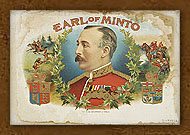 |
 |
EARL OF MINTO
Trimmed nailed wood box (50)
Factory 22 IRD 17 Series of 1915
Likely the Canada Cigar and Tobacco Co. Ltd, Montreal. Que.
CMC D-13429 a-c
The lithograph artist of the Earl of Minto cigar label chose
to depict his subject's experience as aide-de-camp to Major Frederick
Middleton, head of the force sent to quell the North-West Rebellion of 1885.
But Sir Gilbert John Murray Kynynmond Elliot, 4th Earl of Minto (1845–1914),
is better remembered today as Canada's Governor General from 1898 to 1904,
influential in the founding of the National Archives, launching Ottawa's
famous Minto Skating Club, establishing the Minto Cup awarded to the champion
of the Canadian Lacrosse Association, and helping to create the first
tuberculosis foundation in Canada.

|
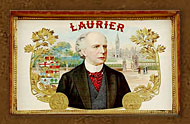 |
 |
LAURIER
Trimmed nailed wood box (25)
Factory 2 IRD 8 Series of 1922
Rock City Cigar Co., Lévis, Que.
CMC 1999.124.18 |

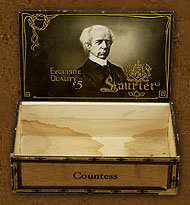 |
 |
LAURIER
Trimmed nailed wood box (50)
Factory 2 Port 13D Circa 1930
Rock City Cigar Co., Lévis, Que.
CMC 1999.124.21
Sir Wilfrid Laurier came to office in 1896 as Canada's first
French-Canadian and second Liberal Prime Minister. An ardent nationalist,
he only reluctantly accepted a knighthood from Queen Victoria and sent
Canadian troops to support Britain during the Boer War; in 1909, he created
the Department of External Affairs to relieve Canada of its dependence on
Britain for international negotiation on its behalf. With the west opening
to European settlement and the country thriving economically, Laurier
confidently stated, "As the nineteenth century was that of the United
States, so I think we can claim that Canada shall build the
twentieth"—which
has come down to us as the slogan, "The twentieth century belongs
to Canada." |
CANADIAN PLACES
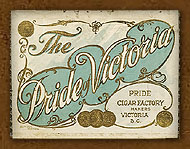 |
 |
THE PRIDE OF VICTORIA
Trimmed nailed wood box (50)
Factory 11 IRD 37 Series of 1897
Pride Cigar Factory, Victoria, B.C.
CMC F-9175
A perusal of early (1883–1900) cigar manufacturers in Victoria,
B.C. reveals an interesting mix of mostly Chinese, German and Jewish names.
The Pride of Victoria cigar was made by M. A. Levy or J. Levy & Sons.

|
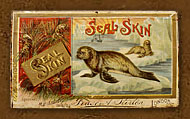 |
 |
SEAL SKIN (The North)
Trimmed nailed wood box (25)
Factory 14 IRD 32 Circa 1897
Fraser & Stirton, London, Ont.
CMC 2004.120.5 a-b
The "Seal Skin" on this turn-of-the-20th-century box
referred to the Inuit reliance on the seal for fur, rather than to the
Newfoundlanders' annual seal hunt to the ice floes off Labrador.
"Swilin'"
would not be part of the Canadian experience until Newfoundland joined the
Dominion
in 1949.

|
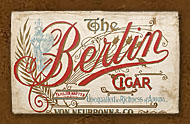 |
 |
THE BERLIN CIGAR
Trimmed nailed wood box (50)
Factory 8 IRD 28 Circa 1897
Von Neubronn & Co., Berlin (Kitchener), Ont.
CMC 2004.38.18
In 1916, the prosperous southwestern Ontario city of Berlin
was Canada's centre of German population (mostly descendents of settlers
from Pennsylvania) and German culture. With anti-German sentiment running
high during World War I, the city was pressured into changing its name.
The choice was "Kitchener," after the British Secretary of State
for War who had just lost his life on a diplomatic mission to Russia. There are
cigar boxes from the town in this era in which a small label
saying "Kitchener" has been pasted over the original
"Berlin".

|
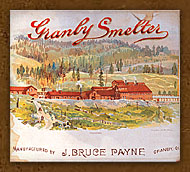 |
 |
GRANBY SMELTER
Trimmed nailed wood box (50)
Factory 1 IRD 10 Circa 1915
J. Bruce Payne, Granby, Que.
CMC 2001.185.2 Tony Hyman Collection
The Granby Smelter in Grand Forks, B.C., was the second largest
operation of its kind in the British Empire from 1900 to 1919. J. Bruce Payne,
a cigar maker in Granby in the Eastern Townships of Quebec, seems to have had
a good sense of humour: he named one of his brands with a punning reference
to the Granby on the other side of the country.

|
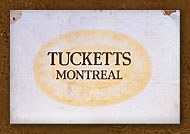 |
 |
TUCKETTS MONTREAL
Trimmed nailed wood box (50)
Factory 5 Port 10-D Series of 1922
Tuckett's, Montreal, Que.
CMC 2001.185.48 Tony Hyman Collection
At the turn of the 20th century, Montreal was Canada's largest
and most cosmopolitan city, its financial and industrial centre, and its
tobacco manufacturing capital.

|
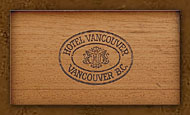 |
 |
HOTEL VANCOUVER
Boite nature with hardware (100)
Factory 8 IRD 26 Circa 1915
R. Roy y Hermano, Toronto, Ont.
CMC F-8828
Major hotels often had a tobacco shop that sold a house brand
of custom-made cigars. |
PULCHRITUDE
Since ancient times, regional poets and troubadours have touted
the beauty of their women. Early cigar makers went a step further and made a
punning connection between their product and the "belles" and "beauties" of their locale.
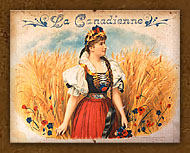 |
 |
LA CANADIENNE
Trimmed nailed wood box (50)
Factory 1 IRD 17 Series of 1897
Likely J. M. Fortier, Montreal, Que.
CMC 2003.46.79 |

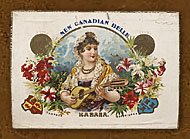 |
 |
NEW CANADIAN BELLE
Trimmed nailed wood box (50)
Factory 5 IRD 28 Series of 1915
Likely H. Von Neubronn, Kitchener, Ont.
CMC 2003.116.11 |

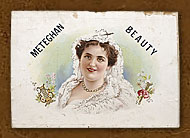 |
 |
METEGHAN BEAUTY
Trimmed nailed wood box (50)
Factory 1 IRD 10 Series of 1897
Likely J. Bruce Payne, Granby, Que.
CMC 2003.116 |

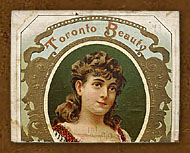 |
 |
TORONTO BEAUTY
Trimmed nailed wood box (10)
Factory 21 IRD 26 Circa 1909
Likely A. Bollard, Toronto, Ont.
CMC 2005.41.16 |

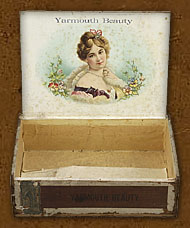 |
 |
YARMOUTH BEAUTY
Trimmed nailed wood box (50)
Factory 3 IRD 4 Series of 1897
Likely Thos. Glenn, Yarmouth, N.S.
CMC 2004.38.16 |
CANADIAN PASTIMES
Leisure activities and most Canadian national sports are
represented on early cigar boxes. The Canadian Museum of Civilization has
a few: there are others in private collections that depict baseball,
football and tug of war. There does not seem to be a box showing lacrosse.
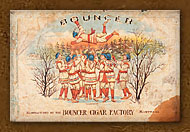 |
 |
BOUNCER
Trimmed nailed wood box (50)
Factory 12 Port 10-D Series C
Bouncer Cigar Factory, Montreal, Que.
CMC 2003.46.51
The image is based on an 1887 photograph called "The
Bounce" or "Habitant Blanket Toss" by Montreal photography
studio William Notman and Son. The men, wearing stylized traditional French
Canadian costume, are members of the Montreal Snow Shoe Club, known as the
"Tuque Bleue" for their blue caps. The popular club, established
in 1840, met for winter woods outings, held races and contests, and sponsored
public entertainments, tableaux, and song performances—the last highly
patriotic, since club members had strong ties to Great Britain (the stripes
on their costumes were the colours of the British flag). "The Bounce"
was lithographed and widely reproduced in contemporary newspapers.

|
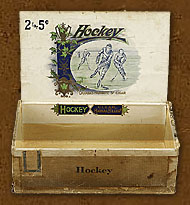 |
 |
HOCKEY
Trimmed nailed wood box (50)
Factory 9 Port 10-D Series C
Z. Davis & Co., Montreal, Que.
CMC 2004.38.13 |

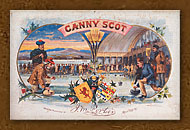 |
 |
CANNY SCOT
Trimmed Nailed Wood box (50)
Factory 1 IRD 17 Series of 1897
J. M. Fortier, Ltd., Montreal, Que.
CMC 2001.185.21 Tony Hyman Collection
This label, with its thistle-to-maple leaf, pond-to-arena transition, artfully shows the transformation of a winter sport—and a people—from Scottish to Canadian.
|
|

































